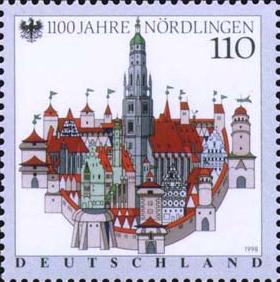
Germany

Denominazione ufficiale: Repubblica Federale di Germania
Official name: Federal Republic of Germany
Nome nella lingua originale: Bundesrepublik Deutschland
Superficie: 357.123,50 km²
Popolazione: 81.772.000 ab. (2010)
Appartenenza: Stato sovrano
Tipo di governo: Repubblica federale parlamentare
Capitale: Berlino
Moneta: Euro
Lingue ufficiali: Tedesco
Nascita: 23 maggio 1949 - Riunificazione 3 ottobre 1990
Area: Europa
Fuso orario: UTC +1
Prima emissione: 1991
Ultima emissione: Attuale
Per saperne di più: http://it.wikipedia.org/wiki/Germania
Annotazioni: Ingresso nell'ONU 18 settembre 1973, ingresso nell'UE 25 marzo 1957. Membro fondatore.

Soggetto: SENZA SOGGETTO Anno: 1998 Notizie: About 15 million years ago a giant impactor between half a kilometer and a kilometer in diameter struck the Earth in what is today Bavaria, Germany. The impactor hit at about a speed of 25 km/sec, forming the 22 to 24 km wide Ries crater. Almost 3.5 cubic kilometers of rock evaporated, 2 cubic kilometers of rock melted, and 31.2 cubic kilometers of rock were ejected as far away as 40 kilometers. The resulting crater was about 240 meters deep. The local rocks melted and fused with portions of the impactor to form an impact breccia called Suevite. Suevite resembles the regolith covering the lunar surface. The smaller Steinheim crater (about 2.5 km in diameter) was formed at the same time as the Ries. The Ries impact event may also be the source of the tektites called Moldavites which are found in the southern Czech Republic. The Apollo 14 astronauts trained at the Ries crater because of its similarity to lunar craters. The town of Nördlingen lies within the confines of the ancient impact crater. Townsfolk used impact breccia to construct St. Georg's Church. This church may be the largest structure in the world composed of impact material. In 1998 Germany issued a stamp commemorating the 1,100th anniversary of the founding of Nördlingen. The stamp shows St. Georg's church with its famous "Daniel" tower, as well as portions of the surrounding town. |
|---|

Soggetto: the P Shoemaker-Levy 9 comet Anno: 1999 Notizie: In 1999 Germany issued a stamp shows the 1994 impact of Comet P/Shoemaker-Levy 9 onto Jupiter. At some point in the recent past Jupiter captured the comet into an unstable orbit about the planet. On July 7, 1992 this new moon of Jupiter passed very close to Jupiter -- within 1.4 Jupiter radii of the giant planet. Powerful stresses induced by this close passage dismembered the fragile comet. The comet was discovered on March 24, 1993 by Eugene and Carolyn Shoemaker and their colleague David Levy during a photographic observation session using the 0.4 meter Schmidt telescope at Palomar Observatory in California. Orbital calculations indicated the comet fragments would probably collide with Jupiter in July 1994. The whole world watched as twenty-one fragments struck Jupiter over a period of week beginning July 16, 1994. Observers were stunned by the spectacular fireballs which appeared as each fragment collided with Jupiter. Dark atmospheric scars persisted for over a year marking the impact sites. The diameter of some of these scars exceeded that of the Earth. Some of the impacting fragments may have been as large as 2 kilometers in diameter. This was the first opportunity ever for scientists to observe such a large collision of a comet with a planet. |
|---|